Dreibergen Rottweilers
Rottweiler Type and Performance
Rottweiler breeding aims at a vigorous dog which, though powerful in general appearance, is not lacking in refinement and is particularly suitable as a companion, guard and utility dog.
It is above middle size, sturdy, slightly elongated, stocky and powerfully built. The body length should exceed the height at the withers by 15% at most. That corresponds to a ratio of 10:9.1 and 10:8.7. In the case of a dog 65cm high at the withers that represents a length of 71.5 to 74.5 cm.
The Rottweiler is a trotter. In motion the back remains firm and relatively still. The course of motion is harmonious, secure, powerful and unchecked with a good length of stride.
The body of the dog is adapted in its construction to forward motion, for which reason the centre of gravity of the whole body lies in the front half of the trunk. Trotting is the kind of gait in which the centre of gravity of the body is supported exclusively by diagonal pairs of limbs and these always move synchronously, ie. are approximately in the same phase at each moment in the course of motion. In trotting the trunk is propelled forward by powerful muscular contraction, whereby motion experiences considerable acceleration. In this the musculature of the trunk, and especially of the back and neck, play an essential part by tightening the spinal column, which is flexible in the dog, and taking part in the synchronous interaction of the diagonal limits. As the latter throws the centre of gravity constantly forward in a straight line, sideways swinging movements of the trunk are absent in trotting, while the back remains relatively still.
Faults of appearance can blur and distort the image typical of the breed. Such faults include a general appearance which is light and lacking in substance, and a body which too long, too short or too narrow. There should not be a lack of refinement. Refinement implies in the dog, descent from forebears which rose above the average in form and working performance. A dog with refinement is also one which is beautiful, noble and proud looking. Size is not the main feature of the refined dog, but beautiful clear outlines and a harmoniously proportioned body. Refinement does not express itself only in the form, but also in posture and character. Temperament without pushiness, courage without wildness, friendliness with a touch of reserve.
The results of breeding are presented at shows, and taken together, they reflect the status of the breed. Here we find that within the range of variations among the top animals, the type leans more towards the upper limit so far as substance is concerned. It is often massiveness that strikes one. Body weight approaches the limit where pleasure in work, agility, endurance and finally health as well as character attributes are unfavorably affected.
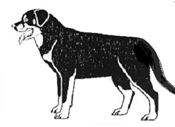
This figure shows a dog that lies at the upper limit of his substance. Excessive weight of the bones and the associated heavy bundles of muscles with fat are a burden which not only limits mobility and endurance but also the internal organs, particularly the heart and lungs can hardly cater for this mass in necessary way
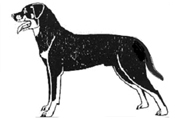
Against the dog that is too heavy we have the type that is too light. Because of the insufficient body weight this is often lacking in assertiveness. The necessary depth of chest and muscle power are often absent. Such dogs are mostly temperamental and uncontrolled.
For the Rottweiler the golden mean should be aimed at this.
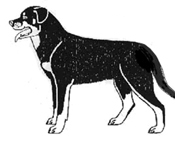
This dog corresponds most closely to the requirements of the standard. In this desirable working type there is a good relationship between the weight and the strength of the bones. The appearance conveys an impression of proportion, size, substance and strength. A powerful deep chest, not flat-ribbed, a well arched thorax provides a good base for the front limbs and sufficient room for the internal organs to carry out their vital function.
For persistent running at the trot the build of a trotter is needed. Here the relationship of power and substance is significant for the desired bouncing and striding motion. The most important thing is a solid structural skeleton which gives support to the body.
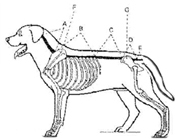
To the structural skeleton belong:
7 neck vertebrae (A)
13 sternal vertebrae (B) with thorax,
7 lumbar vertebrae (C)
3 back vertebrae (D)
and a varying number of tail vertebrae (E)
In the rear part the structures with the backbone, consisting of three ossified back vertebrae, is firmly linked with the pelvic girdle and is supported by the hind extremities.
While the base (lumbar vertebrae, backbone, pelvis) represents an unshakeable combination, the structure is only supported by muscles between the two shoulder blades.
(The next paragraph, comparing the role of the front and rear extremities, (G) & (F), has not been translated as it contains a number of anatomical terms which are not in the ordinary dictionaries)
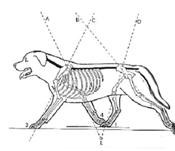
Shows the trotting Rottweiler at the moment when the pair of limbs 2 and 4 have stopped pressing down and are about to rise. The rise and descent of the limits do not take place quite simultaneously, the direction of the two corresponding actions however occurs more or less in parallel and works either against or from the skeleton. The direction is determined by the foot and its undersurface on the one hand and by the support point of the skeleton on the other hand.
E-D = action line (press) - movement phase 1
2-B = action line (lift) - movement phase 2
E-A = action line (lift) - movement phase 3
3-C = action line (press) - movement phase 4
The forces are thought of as being in the medium plane. No account is taken of the rotary effect.

G to C = action line - movement phase 1
2 to F = action line - movement phase 2
G to D = action line - movement phase 4
A to F = action line - movement phase 3
H = resultant pressing force - movement phases 1 and 3
I = resultant lifting force - movement phases 2 and 4
The resultant forces of H and I yield the thrust force. The resultant I of the two lifting forces and the resultant H of the two pressing forces intersect approximately in the middle of the skeleton. The effect of I and H yield and almost horizontal thrust force. It will be seen that the dynamic effect operates as in the case of a bridge. As a trotter the Rottweiler is required to achieve a maximum of endurance through the economical expenditure of forces.
The Intersection G is the turning point of the action lines of the movements phase 1 and 4 at the moment when the lateral support is at its weakest. If this turning point rises above ground level, the dog must proceed from the trot to the gallop, or else run at a constrained and tiring trot.
Observations show that square, well-angled dogs do not run at as demanding a trot as those of more extended build. The opening and closing of the joints proceed according to the laws of the minimum application of force. For that reason the dog that is too long cannot, in continuous trotting, bring his legs sufficiently under the trunk in relation to the length of his body.
The intersection G goes deeper under the ground. The result is that the dog presses down more than it bounces, and expends a great deal of force. Endurance is limited.
The centrifugal forces caused by movement will be saved according to the exercise of running energy. The best result follows when the intersection G, as represented in Fig. 5, lies close before the surface. This takes place when the ratio of length to height corresponds to 10:8.5 to 10:9.
This can only function, however, when the whole system is firmly enclosed within itself with good, strong musculation and precisely working joints. A machine with broken bearings and connecting rods will not run any more. It is clear why sound hips must be demanded.
The turn towards more mass than class, ever bigger and heavier, finds its limits when health, character, mobility and performance are restricted.